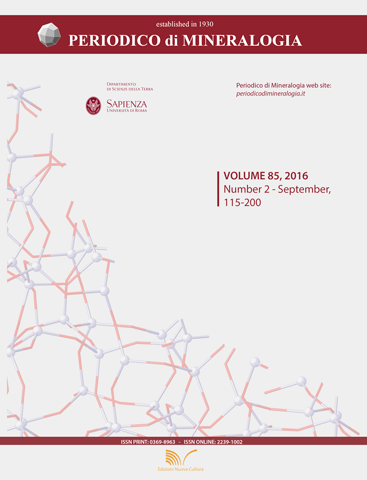Mineralogy and genetic characteristics of the Rudnik Pb-Zn/Cu,Ag,Bi,W polymetallic deposit (Central Serbia) - New occurrence of Pb(Ag)Bi sulfosalts
DOI:
https://doi.org/10.2451/2016PM605Keywords:
Ag-bearing aschamalmite, sulfobismuthites, argentopentlandite, Pb-Zn/Cu, Ag, Bi, W polymetallic ore, Rudnik, SerbiaAbstract
The mineral aschamalmite, of heyrovskyite-like composition, but different in structure, from the Rudnik Pb–Zn/Cu,Ag,Bi,W polymetallic deposit in the central part of Serbia has been investigated. This polymetallic deposit includes over 90 hydrothermal and skarn-replacement orebody types, primarily hosted by Cretaceous sediments and occassionally by Oligocene dykes and sills of dacitic composition, and contact-metamorphic-metasomatic rocks. These rocks are host to an assemblage of pyrrhotite, colloform pyrite, chalcopyrite, galena, arsenopyrite, native bismuth and scheelite as well as minor pyrite, sphalerite, bismuthinite, argentopentlandite, and native silver. The chemical composition of the ore is very complex, where weight contents of valuable metals range as follows (%): Zn 0.49–4.49; Pb 0.90–5.66; Cu 0.08–2.18; WO3 0.05–1.18; Ag 0.005–0.030; Bi 0.005–0.081; and Cd 0.002–0.016. In reflected light, aschamalmite is optically anisotropic, with moderately high bireflectance ranging from slightly greenish to slightly gray. Electron-microprobe analysis gave an average crystallochemical formulae of (Pb5.82Ag0.20)Σ6.02Bi2.03(S8.93Te0.02Se0.01)Σ8.96. The strongest diffraction maximums of the X-ray powder pattern [d(in Å)(I)] are 3.419(100), 3.382(92), and 3.334(66). Monoclinic unit cell parameters are a=13.727(7); b=4.122(3); c=31.32(2) Å; β=90.72(5) o; and V=1771.8(1) Å3. Mineral assemblages and genesis of the Rudnik polymetallic deposit are discussed in detail and the sulfobismuthite mineralization has been compared with similar well-known global deposits.


